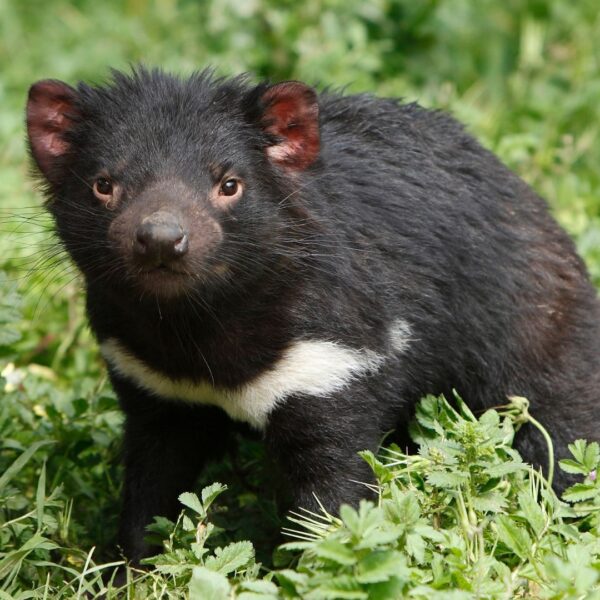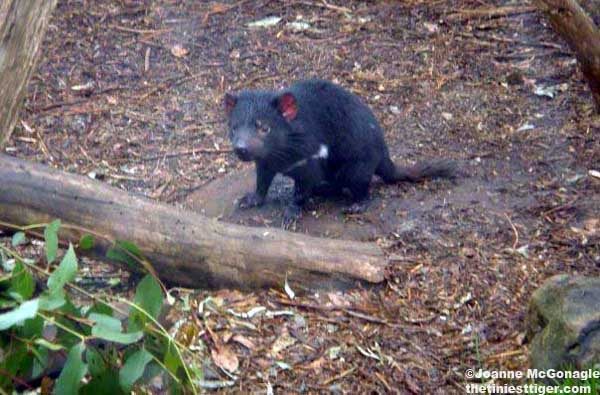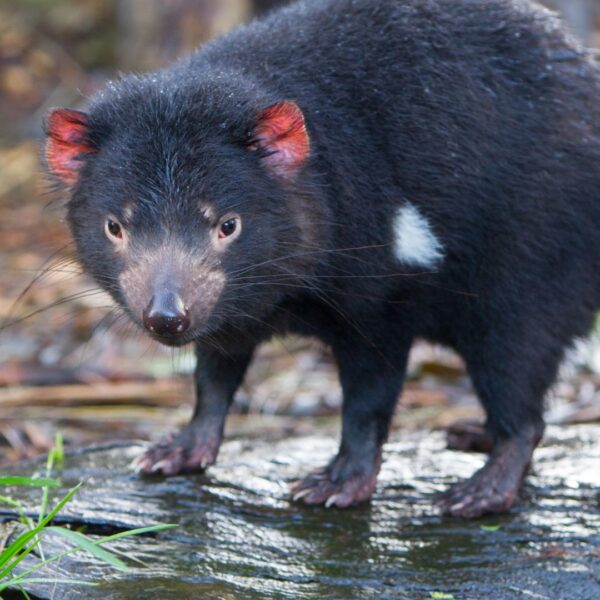
Cats and The Tasmanian Devil: A Complex Relationship
Cats and the Tasmanian Devil are two of the most well-known and fascinating animals in Australia. The Tasmanian Devil is a marsupial that is endemic to the island of Tasmania, while cats are an introduced species that have become widespread across the continent. These two animals have a complex relationship that has been the focus of much research and debate in recent years.
The Tasmanian Devil is a fierce predator that plays an important role in the ecosystem of Tasmania. They are known to eat a wide variety of prey, including small mammals, birds, reptiles, and insects. Cats, on the other hand, are also predators that were introduced to Australia by European settlers in the 1800s. They have since become one of the most successful invasive species in the world, and are known to prey on a wide range of native wildlife.
Despite their different backgrounds and roles in the ecosystem, cats and Tasmanian Devils have been found to interact in a number of interesting ways. For example, research has shown that Tasmanian Devils can help to limit the population of feral cats, which are a major threat to many native species. Conversely, cats may be able to prey on Tasmanian Devils in some situations, which could have important implications for the conservation of this iconic species.
Key Takeaways
- The Tasmanian Devil is a marsupial that is endemic to Tasmania, while cats are an introduced species that have become widespread across Australia.
- Tasmanian Devils play an important role in the ecosystem of Tasmania, while cats are known to prey on a wide range of native wildlife.
- Cats and Tasmanian Devils have a complex relationship that has been the focus of much research and debate in recent years.
Overview of Tasmanian Devils

Physical Characteristics and Behavior
The Tasmanian devil (Sarcophilus harrisii) is a carnivorous marsupial that is native to Tasmania, Australia. Adult Tasmanian devils are around the size of a small dog, weighing between 6 and 12 kg. They have a stocky build, black fur, and a white stripe on their chest. Tasmanian devils are known for their powerful jaws and sharp teeth, which they use to crush bones and eat their prey whole.
Tasmanian devils are nocturnal and solitary animals, spending most of the day sleeping in their dens. They are also known for their loud and aggressive vocalizations, which they use to communicate with other devils and to defend their territory.
Habitat and Distribution in Tasmania
Tasmanian devils are found throughout Tasmania, but are most commonly found in the eastern and northern parts of the island. They inhabit a variety of habitats, including forests, woodlands, and scrublands. Tasmanian devils are also known to live in human-modified environments, such as farmland and suburban areas.
Devil Facial Tumour Disease (DFTD)
Tasmanian devils are currently facing a major threat from Devil Facial Tumour Disease (DFTD), a contagious cancer that is transmitted through biting during social interactions. The disease causes large tumours to form on the face and mouth of infected devils, making it difficult for them to eat and eventually leading to death.
DFTD was first detected in 1996, and has since spread rapidly throughout Tasmania, causing a significant decline in the Tasmanian devil population. Efforts are being made to control the spread of the disease, including captive breeding programs and vaccination trials. However, the future of the Tasmanian devil remains uncertain.
Cats in Australia

Domestic and Feral Cats
Cats are one of the most popular pets in Australia, with an estimated 3.9 million pet cats in the country. However, domestic cats are not the only feline species found in Australia. Feral cats, which are domestic cats that have gone wild, are also present in the country. They are considered an invasive species and pose a significant threat to native wildlife.
Feral cats are found throughout mainland Australia and are estimated to number in the millions. They are highly adaptable and can survive in a wide range of habitats, from deserts to rainforests. They are also skilled hunters and can prey on a variety of small mammals, birds, and reptiles.
Impact on Australian Wildlife
Feral cats are a major threat to Australia’s native wildlife. They are responsible for the decline and extinction of several small mammal species, including the desert bandicoot and the numbat. They also pose a significant threat to birds and reptiles, with some estimates suggesting that they kill over 1 billion animals each year.
In addition to their direct impact on wildlife, feral cats can also indirectly impact other species. For example, they can compete with native predators, such as the Tasmanian devil, for food. This can lead to declines in the populations of these predators, which can then have cascading effects on other species.
Control and Management Efforts
Given the significant impact of feral cats on Australia’s native wildlife, there have been several efforts to control and manage their populations. These efforts include trapping and removal programs, as well as the use of poison baits. There has also been research into developing more effective and humane control methods, such as fertility control.
In addition to these efforts, there is also a growing awareness of the importance of responsible pet ownership. This includes ensuring that domestic cats are kept indoors or in secure enclosures, and that they are desexed to prevent them from breeding with feral cats. By taking these steps, it is hoped that the impact of cats on Australia’s native wildlife can be reduced.
Cats and Tasmanian Devils Conservation and Ecosystem Balance

Role of Apex Predators
Apex predators, such as the Tasmanian devil, play a crucial role in maintaining ecosystem balance. A native apex predator limits an invasive mesopredator, feral cats for example, and protects native prey. They regulate the population of prey species, preventing overgrazing and ensuring the survival of other species in the ecosystem. The loss of apex predators can lead to a cascade of negative effects, including the proliferation of smaller predators, such as feral cats, which can have devastating effects on biodiversity.
Tasmanian Devils as Ecosystem Regulators
The Tasmanian devil, a marsupial native to Tasmania, is an important ecosystem regulator. They are known to prey on a wide range of species, including small mammals, birds, and reptiles. Their presence in the ecosystem helps to regulate the population of these species, preventing overgrazing and ensuring the survival of other species in the ecosystem.
Reintroduction Initiatives
Conservation biologists and ecologists are working to reintroduce Tasmanian devils to areas where they have been extirpated. These reintroduction initiatives are aimed at restoring ecosystem balance and preventing the proliferation of feral cats and other smaller predators. The University of Tasmania’s research on the topic, published in Ecology Letters, suggests that reintroducing Tasmanian devils to areas where they have been extirpated could have a positive impact on biodiversity.
In conclusion, the conservation of apex predators such as the Tasmanian devil is crucial for maintaining ecosystem balance and preventing the proliferation of smaller predators that can have devastating effects on biodiversity. Reintroduction initiatives are an important step in restoring ecosystem balance and preserving the natural heritage of Tasmania.
Interactions Between Cats and Tasmanian Devils

Competition for Resources
Cats and Tasmanian devils are both carnivorous and compete for similar prey such as wallabies, quolls, and bandicoots. As a result, there is a potential for resource competition between these two species. However, it is important to note that Tasmanian devils are apex predators and have a significant impact on the ecosystem. Therefore, the competition for resources may not be as significant as it appears at first glance.
Potential for Coexistence
Despite the potential for competition, there is also the potential for coexistence between cats and Tasmanian devils. Studies have shown that Tasmanian devils can limit the population of feral cats, which are an invasive species in Tasmania. In turn, this can benefit smaller predators such as quolls and bandicoots, which are preyed upon by feral cats. Therefore, Tasmanian devils may indirectly benefit these smaller predators by reducing the number of feral cats.
Impact on Other Native Species
The impact of cats and Tasmanian devils on other native species is complex and depends on the specific interactions between these species. For example, a study has shown that Tasmanian devils can indirectly protect eastern quolls by suppressing feral cats. However, there is also the potential for Tasmanian devils to prey on smaller predators such as quolls and bandicoots. Therefore, the impact of Tasmanian devils on other native species is not straightforward and requires further research.
In summary, the interactions between cats and Tasmanian devils are complex and depend on a variety of factors. While there is the potential for competition between these two species, there is also the potential for coexistence. The impact of these species on other native species is also complex and requires further research.

Research and Studies
Scientific Investigations
Several scientific investigations have been conducted to understand the relationship between feral cats and the Tasmanian devil. One such study was conducted by Calum Cunningham, a PhD candidate at the University of Tasmania. The study aimed to understand the impact of feral cats on small animals in Tasmanian forest ecosystems. The study found that feral cats are a significant threat to small mammals, and their presence has led to a decline in the population of small animals in the area.
Another study used camera traps and statistical models to investigate the cascading effects of the decline of Tasmanian devils on feral cats and their impact on prey. The study found that the decline in Tasmanian devils led to an increase in feral cat populations, which in turn led to a decline in native prey populations. The study suggests that the Tasmanian devil acts as a natural predator that limits the population of feral cats and protects native prey.
Data and Statistical Analysis
The researchers used various data and statistical analysis techniques to understand the impact of feral cats on the Tasmanian devil. They used camera traps to monitor the behavior of feral cats and Tasmanian devils in the area. The data collected from the camera traps was then analyzed using statistical models to understand the interaction between the two predators.
The researchers also used population density estimates to understand the impact of feral cats on small mammals in the area. They calculated density relationships between feral cats, Tasmanian devils, and small mammals to understand the impact of feral cats on the ecosystem.
Overall, the research and studies suggest that feral cats are a significant threat to small mammals in Tasmanian forest ecosystems. The decline of Tasmanian devils has led to an increase in feral cat populations, which in turn has led to a decline in native prey populations. The research suggests that the Tasmanian devil acts as a natural predator that limits the population of feral cats and protects native prey.
Challenges and Future Directions
Threats to Survival
The Tasmanian devil is a threatened species that faces numerous challenges to its survival. The biggest threat to the Tasmanian devil is the Devil Facial Tumor Disease (DFTD), which has caused a significant decline in the devil population. DFTD is a contagious cancer that spreads through biting, which is a common behavior among Tasmanian devils. The disease has caused a significant decline in the devil population, and if left unchecked, it could lead to the extinction of the species.
Another threat to the Tasmanian devil is the presence of invasive predator and prey species, such as feral cats. Feral cats are known to prey on Tasmanian devils, and their presence in the Tasmanian ecosystem is a significant threat to the survival of the species. The decline of the Tasmanian devil population has also led to an increase in the number of feral cats, which further exacerbates the problem.
Conservation Strategies
Conservation biologists have been working to develop strategies to help save the Tasmanian devil from extinction. One strategy is to establish captive breeding programs to help increase the devil population. These programs involve breeding Tasmanian devils in captivity and releasing them into the wild, which helps to increase the genetic diversity of the population and reduce the effects of inbreeding depression.
Another conservation strategy is to develop vaccines to protect Tasmanian devils from DFTD. Scientists have been working to develop a vaccine that can stimulate the devil’s immune system to fight off the cancer cells. If successful, this vaccine could be a significant breakthrough in the fight to save the Tasmanian devil from extinction.
Public Education and Awareness
One of the most critical components of any conservation strategy is public education and awareness. National Geographic and Scientific American have both covered the issue of the Tasmanian devil’s decline, which has helped to raise awareness of the issue. By educating the public about the challenges facing the Tasmanian devil, conservation biologists hope to generate support for conservation efforts and help save the species from extinction.
In conclusion, the Tasmanian devil faces numerous challenges to its survival, but conservation biologists are working tirelessly to develop strategies to help save the species from extinction. By establishing captive breeding programs, developing vaccines, and raising public awareness, we can help ensure that the Tasmanian devil remains a part of the Tasmanian ecosystem for generations to come.

Frequently Asked Questions
What has led to the decline in Tasmanian devil populations?
The primary cause of the decline in Tasmanian devil populations is the spread of devil facial tumor disease (DFTD), which is a contagious cancer that has affected the majority of the Tasmanian devil population. The disease is transmitted through biting, which is a common behavior among Tasmanian devils during mating and feeding. The disease has led to a significant decline in the Tasmanian devil population, with some estimates suggesting that the population has decreased by more than 80% in some areas.
Are there any predator species that commonly threaten Tasmanian devils?
The Tasmanian devil is a top predator in its ecosystem and is not commonly threatened by other predator species. However, the decline in Tasmanian devil populations has led to an increase in the population of feral cats, which are known to prey on Tasmanian devils. In addition, foxes and dogs have also been known to prey on Tasmanian devils.
Is there a connection between felines and Tasmanian devils in terms of evolutionary biology?
Tasmanian devils and felines are not closely related in terms of evolutionary biology. Tasmanian devils are marsupials, while felines are placental mammals. However, both Tasmanian devils and felines are carnivorous and occupy similar ecological niches, which has led to some similarities in their behavior and diet.
Can humans legally adopt Tasmanian devils as domestic pets?
No, it is not legal to adopt Tasmanian devils as domestic pets. Tasmanian devils are protected under Australian law, and it is illegal to keep them as pets without a special permit. In addition, Tasmanian devils are not domesticated animals and are not suitable as pets.
What are some common misconceptions surrounding the Tasmanian devil?
One common misconception surrounding the Tasmanian devil is that it is a vicious and aggressive animal. While Tasmanian devils can be aggressive towards each other during feeding and mating, they are generally shy and avoid humans. Another misconception is that the Tasmanian devil is a solitary animal. In fact, Tasmanian devils are social animals and are known to form groups, or clans, that share food and territory.
How is the Tasmanian devil depicted in popular media, such as cartoons?
The Tasmanian devil is a popular character in cartoons and is often depicted as a wild and uncontrollable animal. However, this portrayal is largely inaccurate and has contributed to some of the misconceptions surrounding the Tasmanian devil. In reality, Tasmanian devils are shy and elusive animals that are an important part of the Tasmanian ecosystem.